Full record of writing python crawlers from scratch_python
The first nine articles have been introduced in detail from the basics to the writing. The tenth article is about being perfect, so we will record in detail how to write a crawler program step by step. Please read it. Be careful
First let’s talk about our school’s website:
http://jwxt.sdu.edu.cn:7777/zhxt_bks/zhxt_bks.html
Check results You need to log in, and then the results of each subject are displayed, but only the results are displayed without the grade points, which is the weighted average score.

Obviously calculating grade points manually is a very troublesome thing. So we can use python to make a crawler to solve this problem.
1. On the eve of the decisive battle
Let’s prepare a tool first: HttpFox plug-in.
This is an http protocol analysis plug-in that analyzes page request and response time, content, and COOKIE used by the browser.
Take me as an example, just install it on Firefox, the effect is as shown: 
You can view the corresponding information very intuitively.
Click start to start detection, click stop to pause detection, and click clear to clear the content.
Generally before use, click stop to pause, and then click clear to clear the screen to ensure that you see the data obtained by accessing the current page.
2. Go deep behind enemy lines
Let’s go to the score inquiry website of Shandong University to see what was sent when logging in. information.
First go to the login page, open httpfox, after clearing, click start to turn on the detection:

After entering the personal information, make sure httpfox is turned on. Then click OK to submit the information and log in.
You can see at this time that httpfox has detected three pieces of information:

At this time, click the stop button to ensure that what is captured is the feedback after visiting the page. Data so that we can simulate login when doing crawlers.
3. Pao Ding Jie Niu
At first glance, we got three data, two are GET and one is POST, but what exactly are they? How to use it, we still don’t know.
So, we need to check the captured content one by one.
Look at the POST information first:

Since it is the POST information, we can just look at the PostData.
You can see that there are two POST data, studid and pwd.
And it can be seen from the Redirect to of Type that after the POST is completed, it jumps to the bks_login2.loginmessage page.
It can be seen that this data is the form data submitted after clicking OK.
Click on the cookie label to see the cookie information:
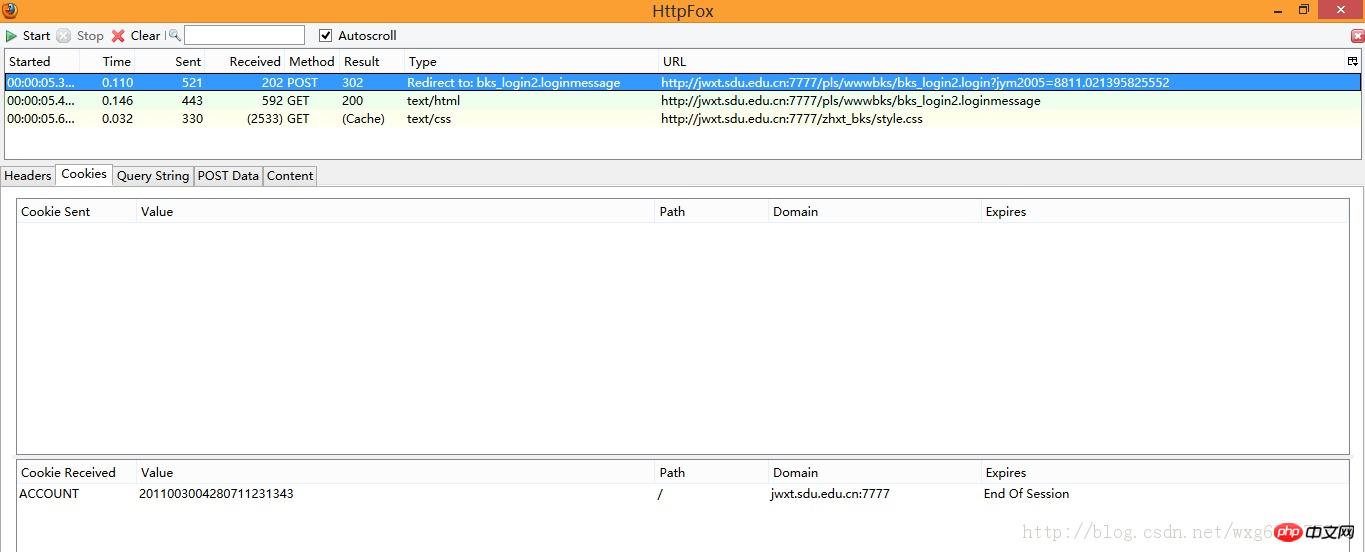
Yes, an ACCOUNT cookie was received and will be automatically destroyed after the session ends. .
So what information did you receive after submitting?
Let’s take a look at the next two GET data.
Look at the first one first. We click on the content tag to view the received content. Do you feel like eating it alive? -The HTML source code is undoubtedly exposed:
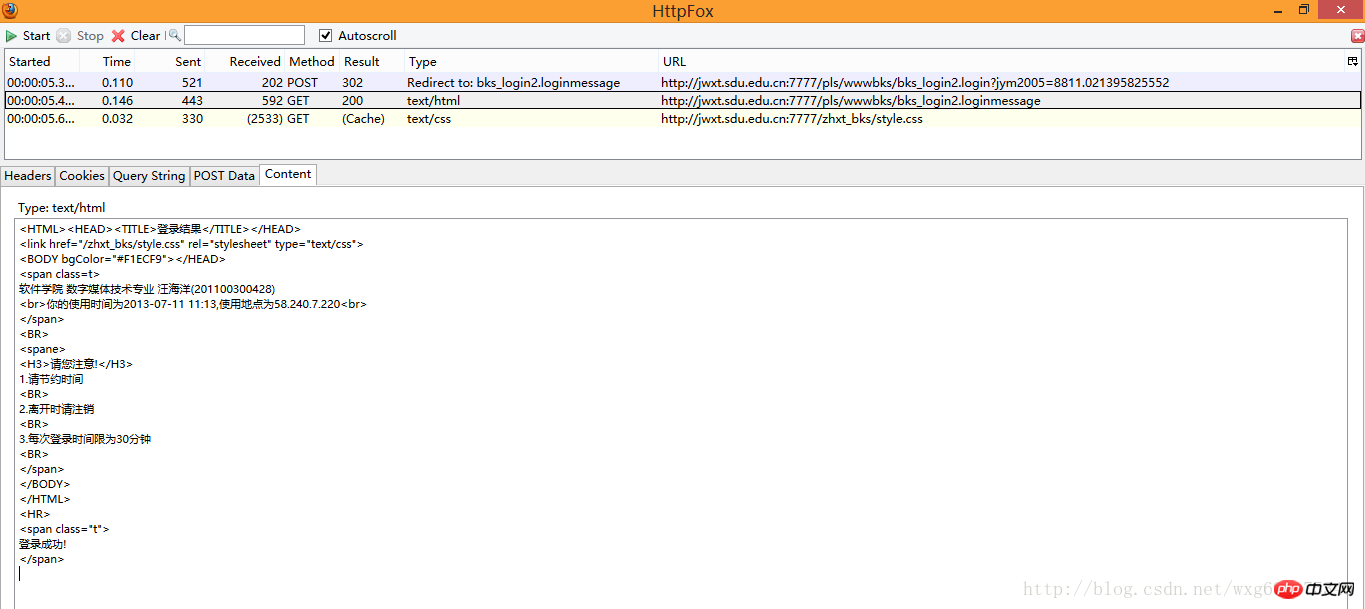
It seems that this is just the html source code of the page. Click on the cookie to view the cookie-related information:

Aha, it turns out that the content of the html page was received only after the cookie information was sent.
Let’s take a look at the last received message:
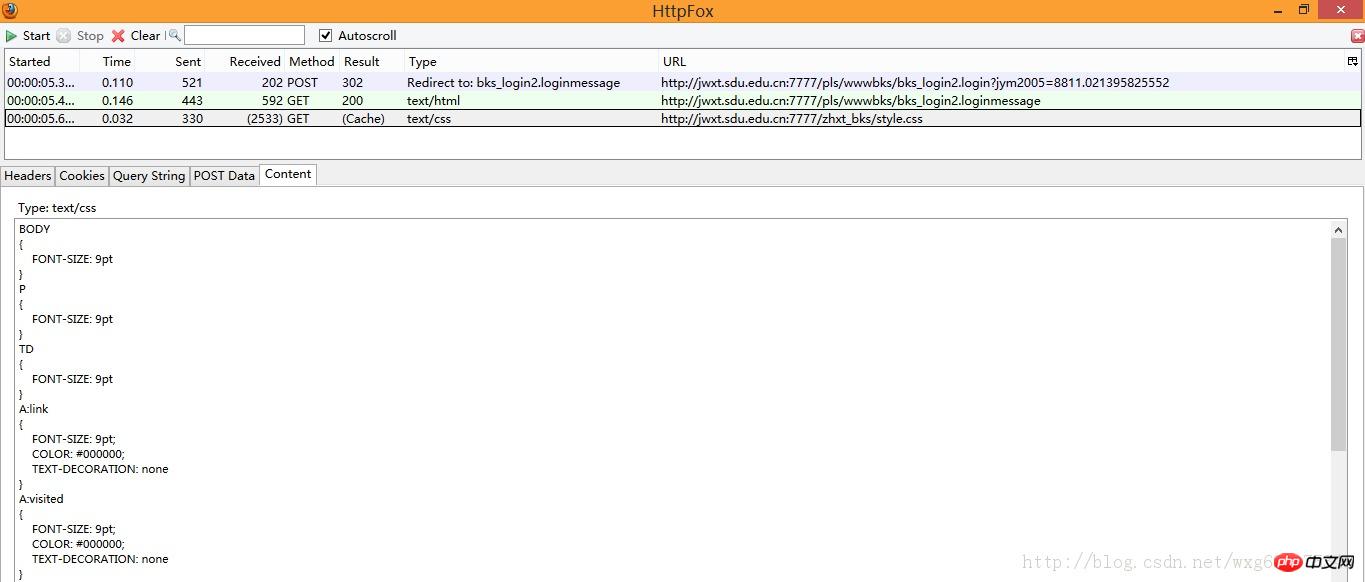
After a rough look, it should be just a css file called style.css, which doesn’t mean much to us. big effect.
4. Calmly respond
Now that we know what data we sent to the server and what data we received, the basic process is as follows :
First, we POST the student ID and password--->Then return the cookie value and then send the cookie to the server--->Return the page information. Obtain the data from the grades page, use regular expressions to extract the grades and credits separately and calculate the weighted average.
OK, it looks like a very simple sample paper. Then let’s try it out.
But before the experiment, there is still an unresolved problem, which is where is the POST data sent?
Look at the original page again:

It is obviously implemented using an html framework, that is to say, the address we see in the address bar is not the address to submit the form on the right.
So how can we get the real address-. -Right-click to view the page source code:
Yes, that name="w_right" is the login page we want.
The original address of the website is:
http://jwxt.sdu.edu.cn:7777/zhxt_bks/zhxt_bks.html
So, the real form submission The address should be:
http://jwxt.sdu.edu.cn:7777/zhxt_bks/xk_login.html
After entering it, it is true:

It’s actually the course selection system of Tsinghua University. . . My guess is that our school was too lazy to create a page, so we just borrowed it. . As a result, the title was not even changed. . .
But this page is still not the page we need, because the page our POST data is submitted to should be the page submitted in the ACTION of the form.
In other words, we need to check the source code to know where the POST data is sent:
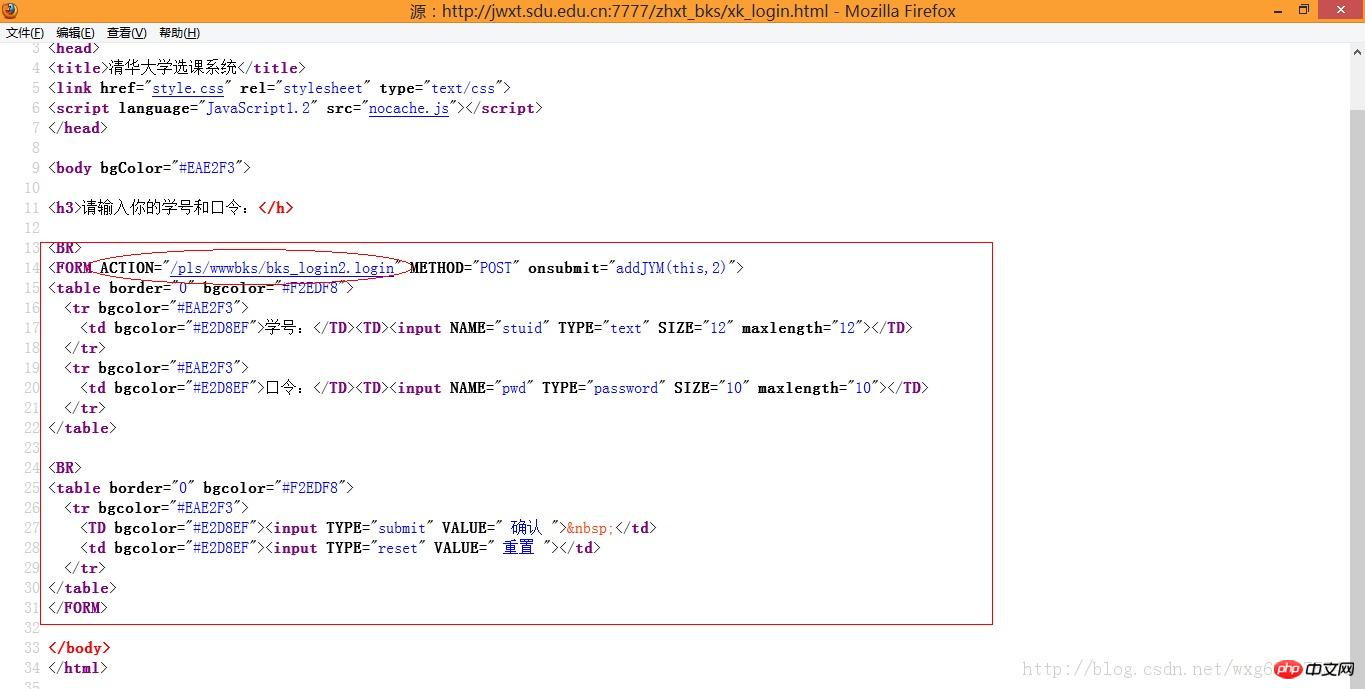
Well, visually this is the POST submission The address of the data.
Arrange it into the address bar. The complete address should be as follows:
http://jwxt.sdu.edu.cn:7777/pls/wwwbks/bks_login2.login
(The way to obtain it is very simple. Just click on the link in Firefox browser to see the address of the link)
5. Try it out
The next task is to use python to simulate sending a POST data and get the returned cookie value.
For the operation of cookies, you can read this blog post:
http://www.jb51.net/article/57144.htm
We first prepare a POST data, then prepare a cookie to receive, and then write the source code as follows:
# -*- coding: utf-8 -*-
#---------------------------------------
# 程序:山东大学爬虫
# 版本:0.1
# 作者:why
# 日期:2013-07-12
# 语言:Python 2.7
# 操作:输入学号和密码
# 功能:输出成绩的加权平均值也就是绩点
#---------------------------------------
import urllib
import urllib2
import cookielib
cookie = cookielib.CookieJar()
opener = urllib2.build_opener(urllib2.HTTPCookieProcessor(cookie))
#需要POST的数据#
postdata=urllib.urlencode({
'stuid':'201100300428',
'pwd':'921030'
})
#自定义一个请求#
req = urllib2.Request(
url = 'http://jwxt.sdu.edu.cn:7777/pls/wwwbks/bks_login2.login',
data = postdata
)
#访问该链接#
result = opener.open(req)
#打印返回的内容#
print result.read()After this, look at the effect of the operation:
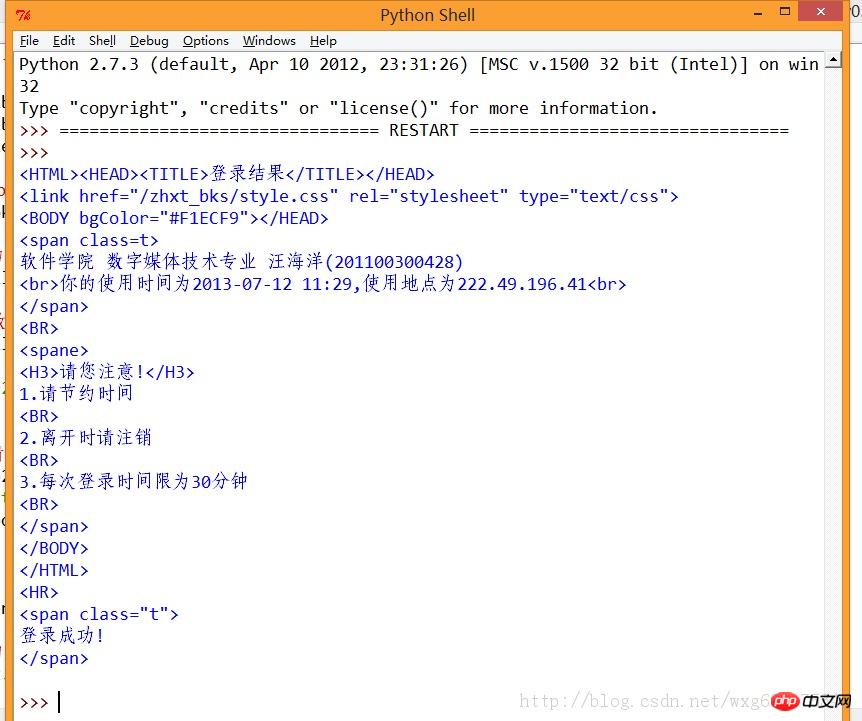
ok, in this way, we can calculate that the simulated login is successful.
6. Stealing the day and changing the day
The next task is to use a crawler to obtain the students’ scores.
Let’s take a look at the source website.
After opening HTTPFOX, click to view the results and find that the following data has been captured:
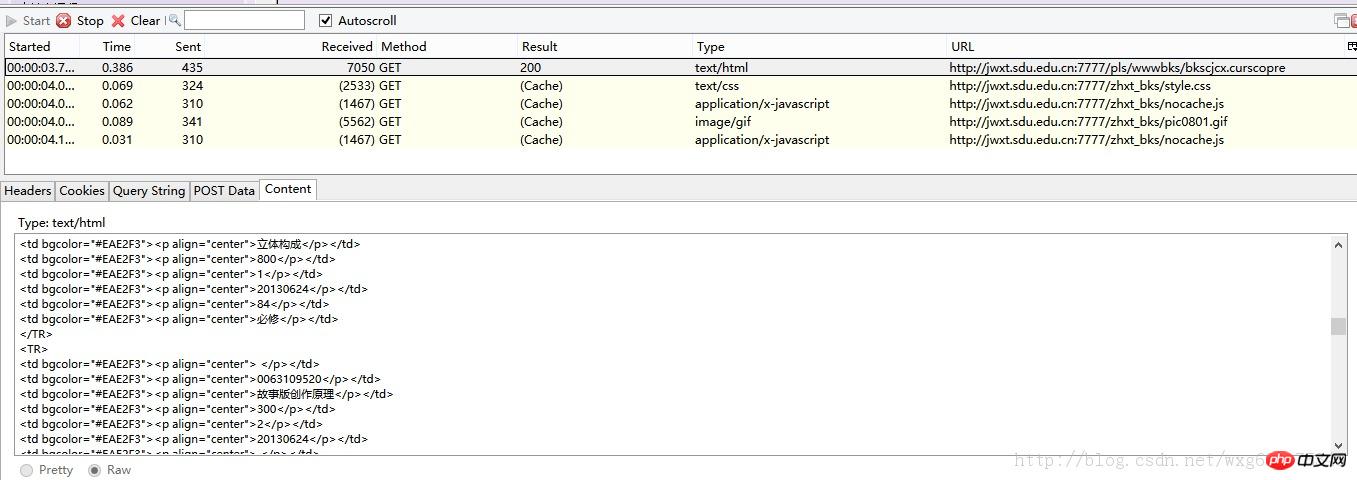
Click on the first GET data to view the content It is found that Content is the content of the obtained score.
For the obtained page link, right-click to view the element from the page source code, and you can see the page that jumps after clicking the link (in Firefox, you only need to right-click and "View this frame". ):
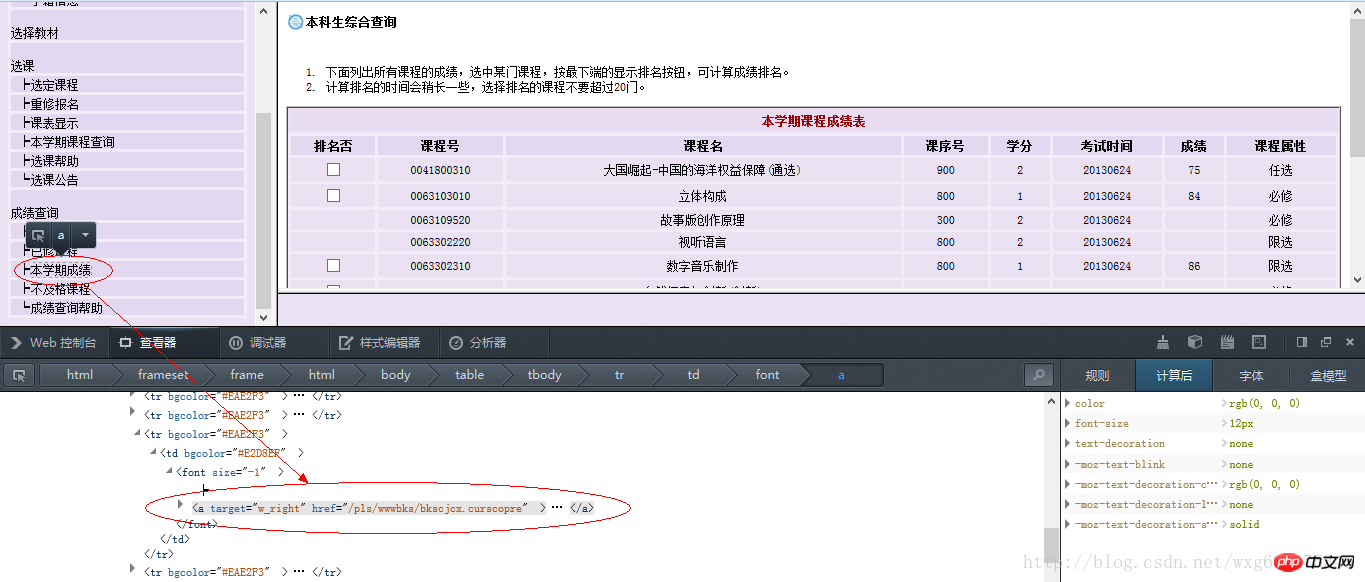
You can get the link to view the results as follows:
http://jwxt.sdu.edu.cn: 7777/pls/wwwbks/bkscjcx.curscopre
7. Everything is ready
Now everything is ready, so just apply the link to the crawler , see if you can view the results page.
As you can see from httpfox, we have to send a cookie to return the score information, so we use python to simulate the sending of a cookie to request the score information:
# -*- coding: utf-8 -*-
#---------------------------------------
# 程序:山东大学爬虫
# 版本:0.1
# 作者:why
# 日期:2013-07-12
# 语言:Python 2.7
# 操作:输入学号和密码
# 功能:输出成绩的加权平均值也就是绩点
#---------------------------------------
import urllib
import urllib2
import cookielib
#初始化一个CookieJar来处理Cookie的信息#
cookie = cookielib.CookieJar()
#创建一个新的opener来使用我们的CookieJar#
opener = urllib2.build_opener(urllib2.HTTPCookieProcessor(cookie))
#需要POST的数据#
postdata=urllib.urlencode({
'stuid':'201100300428',
'pwd':'921030'
})
#自定义一个请求#
req = urllib2.Request(
url = 'http://jwxt.sdu.edu.cn:7777/pls/wwwbks/bks_login2.login',
data = postdata
)
#访问该链接#
result = opener.open(req)
#打印返回的内容#
print result.read()
#打印cookie的值
for item in cookie:
print 'Cookie:Name = '+item.name
print 'Cookie:Value = '+item.value
#访问该链接#
result = opener.open('http://jwxt.sdu.edu.cn:7777/pls/wwwbks/bkscjcx.curscopre')
#打印返回的内容#
print result.read()Press Just run F5 and take a look at the captured data:

Since there is no problem, use regular expressions to process the data a little bit , just take out the credits and corresponding scores.
8. Get it at your fingertips
Such a large amount of html source code is obviously not conducive to our processing. Next, we need to use regular expressions to extract the necessary data. .
For tutorials on regular expressions, you can read this blog post:
http://www.jb51.net/article/57150.htm
Let’s take a look at the results Source code:
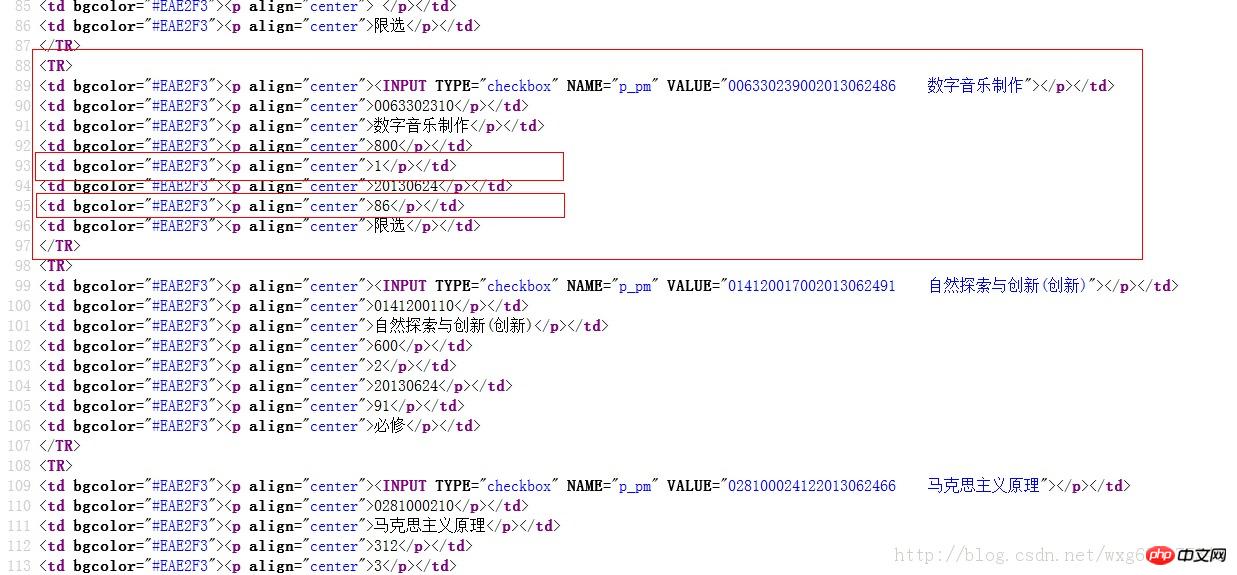
In this case, using regular expressions is easy.
We will tidy up the code a little, and then use regular expressions to extract the data:
# -*- coding: utf-8 -*-
#---------------------------------------
# 程序:山东大学爬虫
# 版本:0.1
# 作者:why
# 日期:2013-07-12
# 语言:Python 2.7
# 操作:输入学号和密码
# 功能:输出成绩的加权平均值也就是绩点
#---------------------------------------
import urllib
import urllib2
import cookielib
import re
class SDU_Spider:
# 申明相关的属性
def __init__(self):
self.loginUrl = 'http://jwxt.sdu.edu.cn:7777/pls/wwwbks/bks_login2.login' # 登录的url
self.resultUrl = 'http://jwxt.sdu.edu.cn:7777/pls/wwwbks/bkscjcx.curscopre' # 显示成绩的url
self.cookieJar = cookielib.CookieJar() # 初始化一个CookieJar来处理Cookie的信息
self.postdata=urllib.urlencode({'stuid':'201100300428','pwd':'921030'}) # POST的数据
self.weights = [] #存储权重,也就是学分
self.points = [] #存储分数,也就是成绩
self.opener = urllib2.build_opener(urllib2.HTTPCookieProcessor(self.cookieJar))
def sdu_init(self):
# 初始化链接并且获取cookie
myRequest = urllib2.Request(url = self.loginUrl,data = self.postdata) # 自定义一个请求
result = self.opener.open(myRequest) # 访问登录页面,获取到必须的cookie的值
result = self.opener.open(self.resultUrl) # 访问成绩页面,获得成绩的数据
# 打印返回的内容
# print result.read()
self.deal_data(result.read().decode('gbk'))
self.print_data(self.weights);
self.print_data(self.points);
# 将内容从页面代码中抠出来
def deal_data(self,myPage):
myItems = re.findall('<TR>.*?<p.*?<p.*?<p.*?<p.*?<p.*?>(.*?)</p>.*?<p.*?<p.*?>(.*?)</p>.*?</TR>',myPage,re.S) #获取到学分
for item in myItems:
self.weights.append(item[0].encode('gbk'))
self.points.append(item[1].encode('gbk'))
# 将内容从页面代码中抠出来
def print_data(self,items):
for item in items:
print item
#调用
mySpider = SDU_Spider()
mySpider.sdu_init()The level is limited, and regular expressions are a bit ugly. The running effect is as shown in the figure:
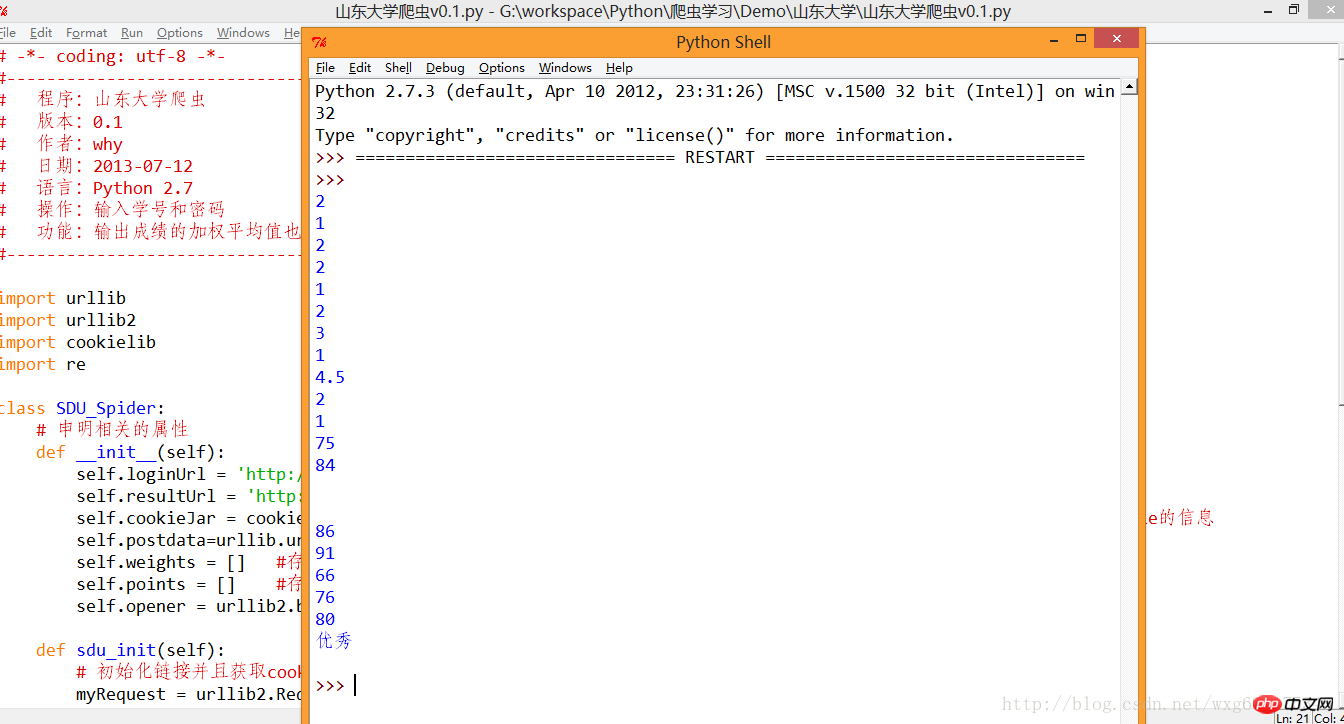
#ok, the next thing is just the data processing problem. .
9. Return in triumph
The complete code is as follows. At this point, a complete crawler project is completed.
# -*- coding: utf-8 -*-
#---------------------------------------
# 程序:山东大学爬虫
# 版本:0.1
# 作者:why
# 日期:2013-07-12
# 语言:Python 2.7
# 操作:输入学号和密码
# 功能:输出成绩的加权平均值也就是绩点
#---------------------------------------
import urllib
import urllib2
import cookielib
import re
import string
class SDU_Spider:
# 申明相关的属性
def __init__(self):
self.loginUrl = 'http://jwxt.sdu.edu.cn:7777/pls/wwwbks/bks_login2.login' # 登录的url
self.resultUrl = 'http://jwxt.sdu.edu.cn:7777/pls/wwwbks/bkscjcx.curscopre' # 显示成绩的url
self.cookieJar = cookielib.CookieJar() # 初始化一个CookieJar来处理Cookie的信息
self.postdata=urllib.urlencode({'stuid':'201100300428','pwd':'921030'}) # POST的数据
self.weights = [] #存储权重,也就是学分
self.points = [] #存储分数,也就是成绩
self.opener = urllib2.build_opener(urllib2.HTTPCookieProcessor(self.cookieJar))
def sdu_init(self):
# 初始化链接并且获取cookie
myRequest = urllib2.Request(url = self.loginUrl,data = self.postdata) # 自定义一个请求
result = self.opener.open(myRequest) # 访问登录页面,获取到必须的cookie的值
result = self.opener.open(self.resultUrl) # 访问成绩页面,获得成绩的数据
# 打印返回的内容
# print result.read()
self.deal_data(result.read().decode('gbk'))
self.calculate_date();
# 将内容从页面代码中抠出来
def deal_data(self,myPage):
myItems = re.findall('<TR>.*?<p.*?<p.*?<p.*?<p.*?<p.*?>(.*?)</p>.*?<p.*?<p.*?>(.*?)</p>.*?</TR>',myPage,re.S) #获取到学分
for item in myItems:
self.weights.append(item[0].encode('gbk'))
self.points.append(item[1].encode('gbk'))
#计算绩点,如果成绩还没出来,或者成绩是优秀良好,就不运算该成绩
def calculate_date(self):
point = 0.0
weight = 0.0
for i in range(len(self.points)):
if(self.points[i].isdigit()):
point += string.atof(self.points[i])*string.atof(self.weights[i])
weight += string.atof(self.weights[i])
print point/weight
#调用
mySpider = SDU_Spider()
mySpider.sdu_init()Related recommendations:
How to use Python crawlers to obtain those valuable blog posts
Example sharing of python dynamic crawlers
The above is the detailed content of Full record of writing python crawlers from scratch_python. For more information, please follow other related articles on the PHP Chinese website!

Hot AI Tools

Undresser.AI Undress
AI-powered app for creating realistic nude photos

AI Clothes Remover
Online AI tool for removing clothes from photos.

Undress AI Tool
Undress images for free

Clothoff.io
AI clothes remover

AI Hentai Generator
Generate AI Hentai for free.

Hot Article

Hot Tools

Notepad++7.3.1
Easy-to-use and free code editor

SublimeText3 Chinese version
Chinese version, very easy to use

Zend Studio 13.0.1
Powerful PHP integrated development environment

Dreamweaver CS6
Visual web development tools

SublimeText3 Mac version
God-level code editing software (SublimeText3)

Hot Topics
 1378
1378
 52
52
 HadiDB: A lightweight, horizontally scalable database in Python
Apr 08, 2025 pm 06:12 PM
HadiDB: A lightweight, horizontally scalable database in Python
Apr 08, 2025 pm 06:12 PM
HadiDB: A lightweight, high-level scalable Python database HadiDB (hadidb) is a lightweight database written in Python, with a high level of scalability. Install HadiDB using pip installation: pipinstallhadidb User Management Create user: createuser() method to create a new user. The authentication() method authenticates the user's identity. fromhadidb.operationimportuseruser_obj=user("admin","admin")user_obj.
 Navicat's method to view MongoDB database password
Apr 08, 2025 pm 09:39 PM
Navicat's method to view MongoDB database password
Apr 08, 2025 pm 09:39 PM
It is impossible to view MongoDB password directly through Navicat because it is stored as hash values. How to retrieve lost passwords: 1. Reset passwords; 2. Check configuration files (may contain hash values); 3. Check codes (may hardcode passwords).
 The 2-Hour Python Plan: A Realistic Approach
Apr 11, 2025 am 12:04 AM
The 2-Hour Python Plan: A Realistic Approach
Apr 11, 2025 am 12:04 AM
You can learn basic programming concepts and skills of Python within 2 hours. 1. Learn variables and data types, 2. Master control flow (conditional statements and loops), 3. Understand the definition and use of functions, 4. Quickly get started with Python programming through simple examples and code snippets.
 Python: Exploring Its Primary Applications
Apr 10, 2025 am 09:41 AM
Python: Exploring Its Primary Applications
Apr 10, 2025 am 09:41 AM
Python is widely used in the fields of web development, data science, machine learning, automation and scripting. 1) In web development, Django and Flask frameworks simplify the development process. 2) In the fields of data science and machine learning, NumPy, Pandas, Scikit-learn and TensorFlow libraries provide strong support. 3) In terms of automation and scripting, Python is suitable for tasks such as automated testing and system management.
 How to optimize MySQL performance for high-load applications?
Apr 08, 2025 pm 06:03 PM
How to optimize MySQL performance for high-load applications?
Apr 08, 2025 pm 06:03 PM
MySQL database performance optimization guide In resource-intensive applications, MySQL database plays a crucial role and is responsible for managing massive transactions. However, as the scale of application expands, database performance bottlenecks often become a constraint. This article will explore a series of effective MySQL performance optimization strategies to ensure that your application remains efficient and responsive under high loads. We will combine actual cases to explain in-depth key technologies such as indexing, query optimization, database design and caching. 1. Database architecture design and optimized database architecture is the cornerstone of MySQL performance optimization. Here are some core principles: Selecting the right data type and selecting the smallest data type that meets the needs can not only save storage space, but also improve data processing speed.
 How to use AWS Glue crawler with Amazon Athena
Apr 09, 2025 pm 03:09 PM
How to use AWS Glue crawler with Amazon Athena
Apr 09, 2025 pm 03:09 PM
As a data professional, you need to process large amounts of data from various sources. This can pose challenges to data management and analysis. Fortunately, two AWS services can help: AWS Glue and Amazon Athena.
 How to start the server with redis
Apr 10, 2025 pm 08:12 PM
How to start the server with redis
Apr 10, 2025 pm 08:12 PM
The steps to start a Redis server include: Install Redis according to the operating system. Start the Redis service via redis-server (Linux/macOS) or redis-server.exe (Windows). Use the redis-cli ping (Linux/macOS) or redis-cli.exe ping (Windows) command to check the service status. Use a Redis client, such as redis-cli, Python, or Node.js, to access the server.
 How to read redis queue
Apr 10, 2025 pm 10:12 PM
How to read redis queue
Apr 10, 2025 pm 10:12 PM
To read a queue from Redis, you need to get the queue name, read the elements using the LPOP command, and process the empty queue. The specific steps are as follows: Get the queue name: name it with the prefix of "queue:" such as "queue:my-queue". Use the LPOP command: Eject the element from the head of the queue and return its value, such as LPOP queue:my-queue. Processing empty queues: If the queue is empty, LPOP returns nil, and you can check whether the queue exists before reading the element.




